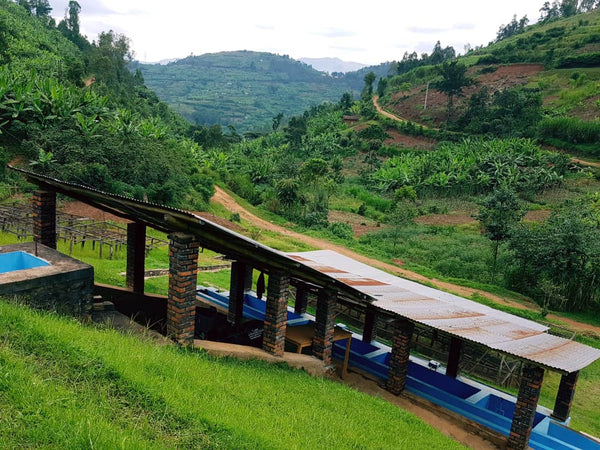Lighthouse: Light Roast (SO)
When travelling through France, you might come across a quaint restaurant, surrounded by cobblestone streets and the smell of freshly baked croissants. Now while walking through this idealized French scene, you might come across a bottle of 'house white' that may sound so underwhelming, and yet, ends up dancing across your tastebuds like Michael Flatley magically floating across an Irish jig.
So when designing our new, always on the menu light roast Red Bourbon, we thought of it as our "house light". Something that could be enjoyed by a broad spectrum of tastes, like those new to light roasts, or for those who just want a clean light roast they can drink, and depend on every day.
But we also didn't want to just call it our house light, as some people might think it's plain. It's anything but. It's a beacon of flavour and warmth in a harrowing storm of terrible coffees littering you grocery store shelf. It is your Lighthouse.
ORIGIN + VARIETY: SINGLE PRODUCER/MICROLOT - Rwanda / Red Bourbon
TASTING NOTES: Caramel + soft fruit notes + easy to drink
ROAST: Light
PRODUCER: Smallholder farmers
FARM: Small farms, often less than one hectare in size
REGION: Northern Province, Gakenke District
ALTITUDE: 1600-1800 masl
PROCESS: Washed
SIZE: Available in 125g, 227g, 340g, 454g, and 908g bags
GRIND: Whole Bean, Filter, French Press and Espresso/Moka Pot.
More about the Producers:
Baho Coffee and Semilla Coffee support and help empower smallholder farmers who have farms that are often not even half a hectare in size. Nieghbouring, smallholder producers group their similar Red Bourbon micro lots together in order to maximize the price they're paid, and improve processing efficacy.
Our partners at Baho and Semilla Coffee have also started a Farmer First program that ensures farmers can get second payments throughout the year, so producers and pickers aren't only paid at harvest. It also allows for workarounds for higher payments than the government imposed ceiling allows, and provides micro financing that producers depend on throughout the year. We also send micro financing donations to the farmers in Rwanda that we work with, alongside our partners.
More about the Processing:
The first step regardless of process is cherry sorting. Under shade, every cherry is sorted to ensure only the ripest are chosen and that any visibly defective cherries are removed.
Next, the hand selected cherries are placed into tanks where they go through multiple rounds of flotation to separate off the defective beans. This washed coffee undergoes a double fermentation process. After depulping, the coffee is immediately dry fermented (placed into an open-air fermentation tank with no water) for 8 to 12 hours. The coffee is then washed and the tank is filled with water for an additional 8 to 12 hour wet fermentation (coffee completely submerged in water). Once the fermentation is complete, the coffee is pushed through the grading channels. Here the coffee is very rigorously washed and separated by density.
The traditional system in Rwanda separates coffees into A, B, and C grades, based on quality (at the moment, we’re only focusing on purchasing of A grades). In Emmanuel’s case, he has extended this into multiple grades within the A range.
After grading, the coffees are soaked (now with no mucilage attached) in a tank of water for a final 8 to 12 hours. This is thought to promote even distribution of moisture throughout the seeds, thus leading to more even drying. After soaking, coffees are moved onto shaded drying beds for 48 - 72 hours. This has two distinct benefits. First, it sets the trajectory for the entire drying phase by initially beginning very gently and slowly under complete shade. Secondly, it allows ample time for additional sorting while the parchment is still wet - this is important because certain defects (Antestia in particular, thought to cause the potato defect ) can be seen much more easily when
the parchment is wet.
Total drying time for this washed coffee is 35 - 40 days.
Brewing Tips:
- ESPRESSO: We recommend either a less traditional 1:2.5 shot. But this pulls really well for a lighter coffee.
- POUR OVER: 20 medium-fine (sand), 300g water. 50g bloom, 100g concentric circle pour, then 20-30g pulse pours for remaining 150g (add pour, wait till drains, repeat). This roast like a a bit of agitation. 3 minutes total time (give or take).
- FRENCH PRESS: We recommend the James Hoffman method for this roast: 16.67:1 ratio // medium grind (not too coarse) // add water, do not stir, brew for 4 minutes // after 4 mins break crust gently, scoop everything that floats // let sit for another 5-8 minutes // don't press all the way, only use it as a filter at the surface of the brew.
- COLD BREW: We prefer this light roast for flash brews, as opposed to cold brew extractions. Follow the above pour over recipe, but use less water (260g or adjust to taste) and drip over large ice cubes.
Read more...








